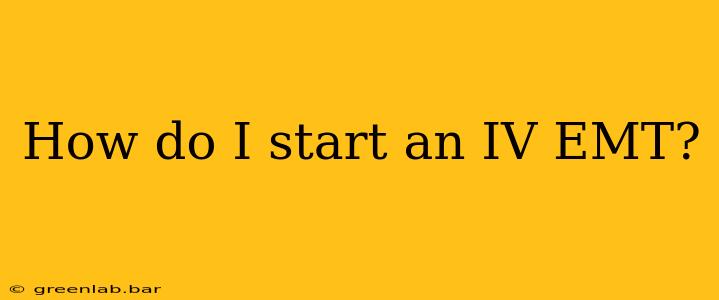Becoming an IV EMT requires dedication, hard work, and a passion for emergency medical services. This guide outlines the necessary steps to launch a successful career as an IV-certified EMT.
Understanding the IV EMT Role
An IV EMT, or EMT-Intermediate, possesses advanced skills beyond a basic EMT. Crucially, they're authorized to administer intravenous (IV) fluids and medications, significantly expanding their ability to treat patients in pre-hospital settings. This often includes managing more complex medical emergencies. The exact scope of practice varies by state and licensing regulations, so it's vital to understand your local requirements.
Step-by-Step Guide to Becoming an IV EMT
1. Obtain Your EMT Certification: The Foundation
Before you can even consider IV certification, you must become a certified Emergency Medical Technician (EMT). This foundational step involves:
- Completing an EMT program: These programs, offered by various institutions (community colleges, vocational schools, and online programs), cover basic life support, patient assessment, and emergency medical procedures. Look for programs accredited by the Commission on Accreditation of Allied Health Education Programs (CAAHEP) or the Committee on Accreditation of Educational Programs for the Emergency Medical Services Professions (CoAEMSP).
- Passing the National Registry of Emergency Medical Technicians (NREMT) exam: This national certification demonstrates competency and is often a prerequisite for employment. Some states have their own state-level exams as well.
- Obtaining your state license: Once you pass the NREMT exam, you’ll need to apply for and obtain your state EMT license. Requirements vary by state.
2. Enroll in an IV EMT Course: Expanding Your Skills
With your EMT certification in hand, you can enroll in an IV EMT course. These courses typically build upon the EMT curriculum and include:
- Intravenous therapy: Comprehensive training in starting IV lines, administering fluids and medications, and managing complications.
- Advanced pharmacology: A deeper understanding of medications used in pre-hospital settings.
- Advanced assessment techniques: Refining skills to identify and manage more complex medical conditions.
- Practical experience: Hands-on training and simulations are crucial to gaining confidence and proficiency.
Choosing the Right Program: Look for programs with experienced instructors, a strong reputation, and opportunities for practical training. Consider program length, cost, and scheduling options when making your decision.
3. Pass the IV EMT Certification Exam: Proving Your Competency
After completing your IV EMT course, you'll typically need to pass a certification exam demonstrating mastery of the advanced skills you’ve learned. This exam may be offered by your state or a national certifying body.
4. State Licensure and Renewal: Maintaining Your Credentials
Once you've completed your IV EMT certification, you'll need to obtain your state license to practice. This often involves background checks and meeting specific state requirements. Remember to stay up-to-date on licensing renewal requirements to maintain your certification.
Beyond Certification: Essential Skills and Considerations
- Continuing Education: The medical field is constantly evolving. Staying current through continuing education courses will ensure you maintain your skills and knowledge.
- Networking: Building relationships with other EMTs and medical professionals can open doors to new opportunities and mentorship.
- Physical Fitness: The job is physically demanding, so maintaining a high level of fitness is essential.
- Emotional Resilience: Dealing with traumatic events is part of the job. Developing strategies for stress management and emotional resilience is crucial.
Career Opportunities for IV EMTs
IV EMTs are highly sought after and can work in various settings, including:
- Emergency Medical Services (EMS) agencies: This is the most common path for IV EMTs.
- Hospitals: Working in hospital emergency departments or transport services.
- Air medical services: Working as a flight paramedic or EMT on helicopters or fixed-wing aircraft (often requiring further certifications).
Becoming an IV EMT is a challenging but rewarding career path. By following these steps and staying committed to your professional development, you can embark on a fulfilling journey in emergency medical services. Remember to always prioritize patient care and safety.

